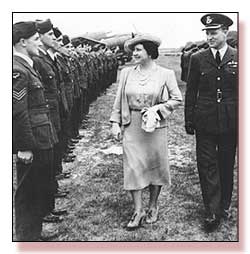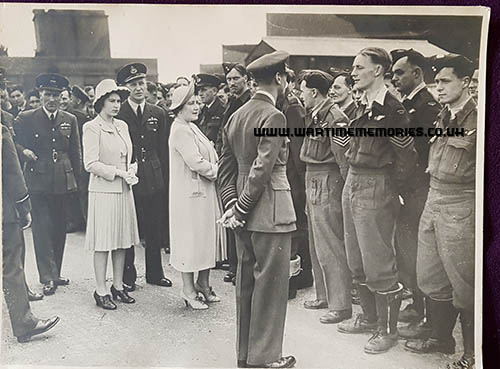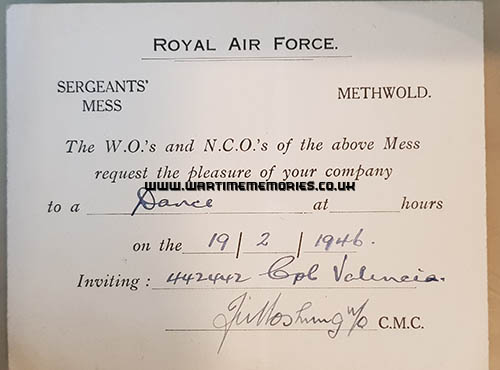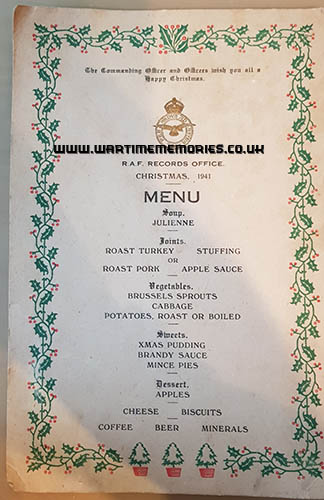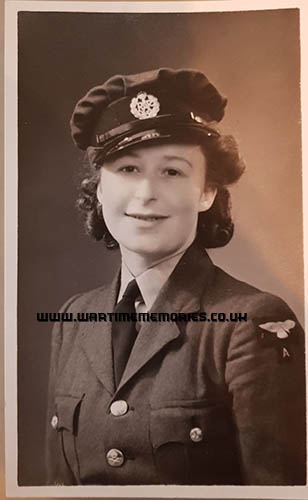|
|
|
Those known to have served at RAF Methwold during the Second World War 1939-1945. - Abrams. R W . Sergeant (d.6th June 1944 )
- Bellamy. F W . Sergeant (d.6th June 1944)
- Brown. A H . Sergeant (d.6th June 1944)
- Findley George Fenwick.
- Hannaford. W A . Warrant Officer (d.6th June 1944)
- Hart. R H S . Flight Sergeant (d.6th June 1944)
- Hornby. J B . Flying Officer (d.6th June 1944)
- Hutchins. C J K . Squadron Leader (d.6th June 1944)
- Johnston David Garth. P/O
- Joslin. Eileen Murial . Corporal
- Letts George Albert. Sgt.
- Logue Spencer H.. FO
- McCoy. W C . Flight Sergeant (d.6th June 1944)
- McDougall William Armour. Sgt. (d.25th June 1944)
- Moores. Kenneth .
- Morris Derek. Sgt. (d.31st Dec 1944)
- Ricketts Albert. F/Lt.
- Valencia Leah. Cpl.
- Wincott. A R . Flight Sergeant (d.6th June 1944)
The names on this list have been submitted by relatives, friends, neighbours and others who wish to remember them, if you have any names to add or any recollections or photos of those listed,
please
Add a Name to this List
|
|
|
The Wartime Memories Project is the original WW1 and WW2 commemoration website.
Announcements
- The Wartime Memories Project has been running for 24 years. If you would like to support us, a donation, no matter how small, would be much appreciated, annually we need to raise enough funds to pay for our web hosting and admin or this site will vanish from the web.
- 22nd April 2024 - Please note we currently have a huge backlog of submitted material, our volunteers are working through this as quickly as possible and all names, stories and photos will be added to the site. If you have already submitted a story to the site and your UID reference number is higher than 263973 your information is still in the queue, please do not resubmit, we are working through them as quickly as possible.
- Looking for help with Family History Research?
Please read our Family History FAQ's
- The free to access section of The Wartime Memories Project website is run by volunteers and funded by donations from our visitors. If the information here has been helpful or you have enjoyed reaching the stories please conside making a donation, no matter how small, would be much appreciated, annually we need to raise enough funds to pay for our web hosting or this site will vanish from the web.
If you enjoy this site
please consider making a donation.
Want to find out more about your relative's service? Want to know what life was like during the War? Our
Library contains an ever growing number diary entries, personal letters and other documents, most transcribed into plain text. |
|
We are now on Facebook. Like this page to receive our updates.
If you have a general question please post it on our Facebook page.
Wanted: Digital copies of Group photographs, Scrapbooks, Autograph books, photo albums, newspaper clippings, letters, postcards and ephemera relating to WW2. We would like to obtain digital copies of any documents or photographs relating to WW2 you may have at home. If you have any unwanted
photographs, documents or items from the First or Second World War, please do not destroy them.
The Wartime Memories Project will give them a good home and ensure that they are used for educational purposes. Please get in touch for the postal address, do not sent them to our PO Box as packages are not accepted.
World War 1 One ww1 wwII second 1939 1945 battalion
Did you know? We also have a section on The Great War. and a
Timecapsule to preserve stories from other conflicts for future generations.
|
|
Want to know more about RAF Methwold? There are:41 items tagged RAF Methwold available in our Library There are:41 items tagged RAF Methwold available in our Library 
These include information on officers, regimental histories, letters, diary entries, personal accounts and information about actions during the Second World War. |
|
George Fenwick Findley 218 (Gold Coast) Squadron. My uncle George Fenwick Findley was the last of his crew members of 218 Gold Coast Squadron. They were:- Bill Streeter RAF
- Tom Mankelow RAF
- Robert Daniel Stirling DFC, pilot RAAF
- Paul Chase Miller RAAF
- Lancelot Keith Gregory RAAF
- George Seymour RNZAF
Uncle George was an air gunner. He enlisted at No2 ITS Bradfield park and trained at No2 WAGS parkes, Port Pirie, Bradfield Park, Melbourne. He travelled to England and continued his training at 11OTU, 1657CU RAF Stradishall, 1483 RAF Newmarket and joined 218 Squadron. He flew from Downham Market, Tempsford, Woolfox Lodge, and Methwold. Operations he flew were: - 3/10/1943 ops mining
- 24/10/1943 ops mining Frisian islands
- 7/11/1943 ops mining Bordeaux
- 18/11/1943 ops Mannheim
- 19/11/1943 ops Leverkusen
- 22/11/1943 ops Berlin
- 1/12/1943 Skaggerack
- 28/1/1944 ops mining Denmark
- 4/3/1944 special target
- 7/3/1944 special target
- 18/4/1944 ops mining Keil Bay
- 20/4/1944 ops bombing Chambley
- 22/4/1944 bombing Laon
- 23/4/1944 ops bombing Brussels
- 25/4/1944 ops bombing Chambley
- 1/5/1944 ops bombing Chambley
- 7/5/1944 ops mining La Rochelle
- 13/5/1944 ops mining Cherbourg
- 5/6/1944 ops special duties for D-Day
- 17/6/1944 ops bombing Montider
- 21/6/1944 ops mining Guernsey
- 24/6/1944 ops bombing Rimeux
- 23/7/1944 ops mining Brest
- 25/8/1944 ops bombing Russelsheim
- 29/8/1944 ops bombing Stettin
- 31/8/1944 ops bombing
- 10/9/1944 ops bombing le Harve
- 14/10/1944 ops bombing Duisburg
- 14/10/1944 ops Duisburg
- 18/10/1944 ops bombing Bonn
- 22/10/1944 ops bombing Neuss
- 23/10/1944 ops bombing Essen
- 26/10/1944 ops Leverkusen
- 30/10/1944 ops bombing Wesseling
- 31/10/1944 ops bombing Bottrop
The aircraft he flew in are: Wackett, Fairy Battle, Wellington, Stirling 111, Lancaster 1. He was a member of 218 squadron from 29/9/1943 to 21/10/1944 in the crew of Lancaster HA-E.
|
F/Lt. Albert Ricketts 21 Sqd. Operation Oyster, was a daylight-bombing raid on Phillips Radio Works, Holland, on December 6th 1942. This raid was at the time the largest daylight-bombing raid of the war. This is an account by Fl. Lt Albert Ricketts and is an extract from his WW11 Memoirs. Albert had trained as a pilot and was eventually posted to 21 squadron based at Methwold, Norfolk. Operation Oyster was his first bombing raid (undertaken on his mother?s birthday); he held the rank of Sergeant and piloted a Lockheed Ventura aircraft with a crew of 4. At the end of the raid his aircraft ditched into the sea about 7 miles off Felixstowe and all were safely recovered.
My arrival at 21 Sqdn, which was positioned at RAF Bodney, which was a satellite to RAF Watton, in Norfolk, heralded the start of all that I had wanted since I joined the RAF and for which my training had hopefully prepared me.
The squadron had very recently been re ? equipped with Lockheed Ventura A/c which was a medium daylight bomber carrying 3 x 500lb and 4 x 250lb bombs, replacing the Bristol Blenheim Mk 4 which had done sterling work both in the Middle East and Northern Europe. The Squadron had recently returned from the Middle East where they had been involved in a low level attack on the German Fleet at Taranto in the Mediterranean Sea. Not only was 21 Sqdn being re ? equipped but the whole of 2 Group, which was a daylight Bomber group within Bomber Command, was also being re ? equipped with other types of aircraft which included Douglas Bostons, North American Mitchells, perhaps better known as the B 25 which was famed for its raid on Tokyo where the aircraft took of from an Aircraft Carrier. Later on De Havilland Mosquitoes also joined the Group.
Whilst at Bodney I went on an SBA refresher course at RAF Horsham St. Faith which was on the outskirts of Norwich. Whilst I was on that course, the Sqdn moved to RAF Methwold which was a satellite to RAF Feltwell, again in Norfolk. At Feltwell was our sister Squadrons on Venturas. These were, 464 RAAF Sqdn and 487 RNZAF Sqdn making up 140 Wing of 2 Group of Bomber Command..
The first Operations carried by the recently re - equipped Group were Cloud Cover operations. This was individual aircraft flying to the target in cloud and only dropping out occasionally to verify its position and adjust accordingly. One of our crews were briefed to bomb the port of Rotterdam in the Netherlands and following the laid down procedure eventually broke cloud immediately over Rotterdam harbour just as our training said he would. I joined the Squadron too late to be competent enough to take part in these operations during which we lost we lost 3 aircraft & crews. One of those aircraft was piloted by a Canadian by the name of Sgt Henry whose aircraft was lettered ' R '.
When the replacement was delivered on the 27/11/42 to our parent station at R.A.F. Feltwell, the home of our sister squadrons, and modified to bring it up to date, I was told that this was to be my A/c and would be lettered ' R '. Interestingly, each one of my crew had the letter ' R ' in their initials namely R. S. Thompson, E. R. Goddard, W. R. Legge and myself A. V. Ricketts. After a considerable amount of training, we were adjudged to be capable of carrying out this type of operation and were briefed to bomb the harbour at Antwerp in The Netherlands. Being briefed to fly in cloud at 1000 ft with the freezing level at 800 ft, I didn't fancy the idea of the A/c being coated in ice and was pleased when the operation was called off for that reason.
That was the last we heard of Cloud Cover operations, for a while. We then concentrated our training on daylight low level operations and from the 21st to 30th Nov, numerous factories in England were ' bombed ' during these practices. We air tested our aircraft both on the 30th Nov and 1st Dec in view of the forthcoming raid. Eventually on the 2nd Dec we were briefed for a raid on the Phillips Radio Works at Eindhoven in The Netherlands. This was going to be, so far, the largest daylight bombing operation of the War involving the whole of 2 Group amounting to about 100 aircraft made up of Bostons, Mitchells ( B25s ) some Mosquitoes and of course Venturas. Due to fog at the target, the raid was put back daily. Each day, whilst the weather at base was good, there was fog at the target and so there was nothing for it but to return to the mess and enjoy the liquid refreshment but bed was the least thing on our minds.
At last on the 6th (my mother's birthday ) the weather was favourable and at 1230hrs, after re ? briefing, it was all systems go and the relief and anticipation was plain for all to see. We got into our A/c ' R ' but my air gunner reported that the gun turret was u/s (unserviceable ) and we had to change to another A/c i.e. ' P '. We found out some days later that the flap, which could be raised to enable the air gunner to get in and out of the turret more easily and which had attached to it a control column to make the turret rotate, to raise and lower the guns ( 2 ) with a firing button at the top, could only be brought down with the guns in the ' up ' position, otherwise the turret would not operate.
By this time all of the Squadron A/c had taken off. Having waited this long we were not going to be denied the opportunity of ' fighting the enemy ' and so we were anxious to get airborne as quickly as possible. In doing so I didn't strap myself in and as soon as the last crew member was inside the A/c and before the door was properly shut, we were building up speed for take off. The fact that we swung on take off and narrowly missed the Air Traffic Control building didn't seem to matter.
We were on our way and anxious to catch up with the squadron aircraft who, by this time, were out of sight. It wasn't too long before we could see them in the distance and was catching up quite quickly. Because we were the last to take off we eventually joined up at the back of the ' gaggle ' of A/c. Having now ' joined up ' with the rest of the squadron, I was able to relax ( as much as one could flying at 235mph at 0 ft. ) Our Sqdn was on the starboard side of 464 Sqdn who was leading the Wing on this operation with 487 Sqdn being on their port side.
Eventually we reached the English coast and crossed it at Southwold in Suffolk. Now over the water without any trees or buildings to hamper us we were right down on the water so as to prevent the German Radar from picking us up and making life difficult for us when we crossed into Holland.
Having been over the water for about 10 mins or so, I saw an aircraft of 464 Sqdn dive into the sea seemingly for no apparent reason. I had to remind myself not to do the same. The course that 464 was flying kept pushing our Sqdn slightly to starboard which meant that when we crossed the Dutch Coast it was over a bird sanctuary so that the noise caused the birds to take off and fly into the aircraft as they passed over. One of the birds hit our windscreen in front of the navigator?s position leaving a bloodstain where it had hit.
The navigator of the Ventura doubled up as the bomb aimer and therefore sat in front of an alleyway to enable him to move down into the bomb-aimer?s position although in this raid, because it was low level, myself as the pilot would release the bombs.
On both sides of the nose of the Ventura were 4 small windows, some of them by the alleyway, and a bird came in through one of them, up the alleyway and hit Ron Thompson in the unmentionables. It wasn't until he saw the feathers that he realised it wasn't his blood. Now we were over land which was quite flat and with ' flak ' towers about 30 ft high, we had to fly as low as possible so as to avoid being shot at. Not long after crossing the Dutch coast we were in the area of the ' dykes ' and of course there were roads on some of these. It came as a bit of a surprise to see a fellow on a bike some 10 ft or so higher than our A/c riding along one of them. He seemed oblivious to our a/c and this was reported by other crews.
Our prearranged track took us to a place called Turnhout where we made a port turn on to our course to Eindhoven which was about 12 miles away. It wasn't long before we were being shot at by guns on the top of the Phillips factory. As we were approaching the factory the bomb doors were opened ready for the bombs to be released. As we were the last A/c to drop our bombs it wasn't surprising that, with the bombing that had gone on before we arrived, the factory was well and truly alight and billowing smoke. The incendiaries we were dropping were of a new type ( for the period ) and exploding on impact the contents would stick to whatever it hit and continue burning.
Unfortunately the A/c in front of me was too close to the building when his bombs exploded so that they stuck to his plane and it went down in flames after he passed over the factory. Not wanting to suffer the same fate, as soon as I had released our bombs, I made the A/c climb rapidly and so we disappeared into the smoke and levelled out at about 600ft. I continued to fly at that height blind and on instruments until we were out of the smoke and then realised how vulnerable we were.
I pushed the nose of the A/c down quickly so as not to attract the anti - aircraft fire little realising the confusion this was causing to Bill Legge who was the air gunner in the downward rear facing gun position. These guns were fed by a switch back system from the bullet panniers positioned on both sides of the A/c. These switch backs didn't have a cover on them and the sudden descent of the A/c caused the bullets, which were linked together, to come out of the switch backs and wrap themselves around Bill's neck.
The expletives he used were unprintable. However now that we were back to ground level, it wasn't long before we were being shot at once again from the flak towers, making us fly even closer to the ground. Not long after leaving the target I managed to make the A/c hit a tree. Fortunately we hit it head on and about one third of the way down. Had it been a wing that hit the tree I would not be alive today to tell this story. The impact was not such that it would cause us to crash but did enough damage to make life quite difficult for us to keep flying. It wasn't too long before I realised that the pitot head ( that that provides the force of air for the air speed indicator to work ) had been ripped off.
Part of the underside of the wing had been ripped away so that Ron was able to see the ground through the side of the A/c. Just before we were about to leave the Dutch Coast our starboard engine packed up. I could only conjecture that the collision had damaged the pipe line to the engine and I had no alternative but to feather the prop and fly on only one, again a practice I had carried out quite often. This was necessary so as to reduce 'drag' and stay airborne.
At about this time I realised that we had lost a lot of fuel and therefore I felt it imperative that we made a landfall in the U.K. as quickly as possible and so we altered course for Felixstowe in Suffolk. Gradually inching higher and higher so that if an emergency occurred we would have sufficient height to deal with it. It wasn't too long before we were at 1,300ft although without any idea of the speed at which we were flying it was important that I didn't cause the A/c to lose flying speed and thereby stall and lose the height that I had been able to gain. Although I didn't think of it at the time, I realised later how much I appreciated all the training I had been put through and the thoroughness with which my instructors had done their job.
|
Sgt. William Armour McDougall 149 Sqn (d.25th June 1944) Bill McDougall was a close childhood friend of my late father, who was also in the RAFVR. Bill was attached to 149 Squadron, based at RAF Methwold, and was part of the crew of EF140, shot down over the French coast on the night of 24th/25th of June 1944. He is buried at the Etaples Military Cemetery.
I have a letter Bill wrote to my father in April 1944. This is probably one of the last letters he wrote and, quite poignantly, he mentions not telling his mother he was on live operations because he didn't want her worrying. Bill's mother had given each of the boys a gold half-sovereign. My father's coin is now with my daughter.
If anyone who knew Bill reads this I would love to get in touch.
|
Sgt. George Albert Letts I have reason to believe that my grandfather,Sgt George Albert Letts spent some time at RAF Methwold in June 1944, and was wondering if anyone has any information.
|
FO Spencer H. Logue 149 Squadron After leaving 1669 Conversion unit, Langar, my father, Spencer Logue, was posted to Methwold, 149 Squadron in March 1945 flying Lancasters. He finished the war there flying POWs back from Germany, and his last entry in his logbook is 23rd of May 1945.
|
P/O David Garth Johnston 149 Squadron 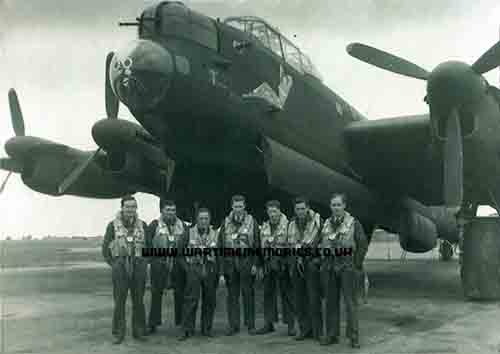 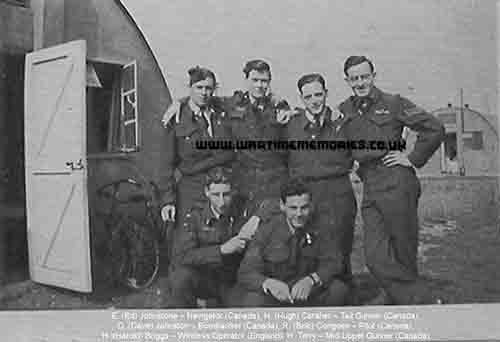 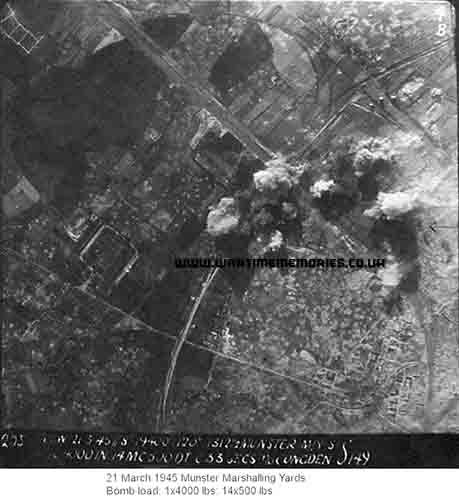 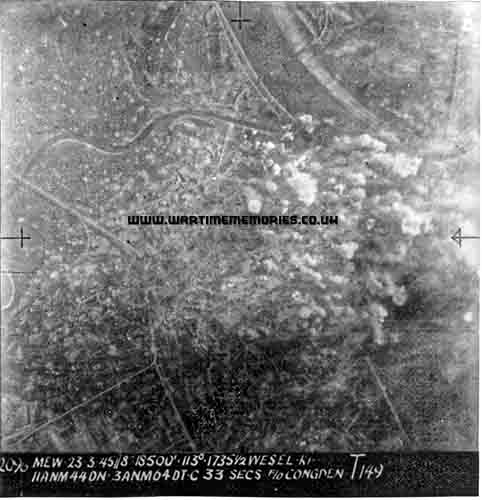 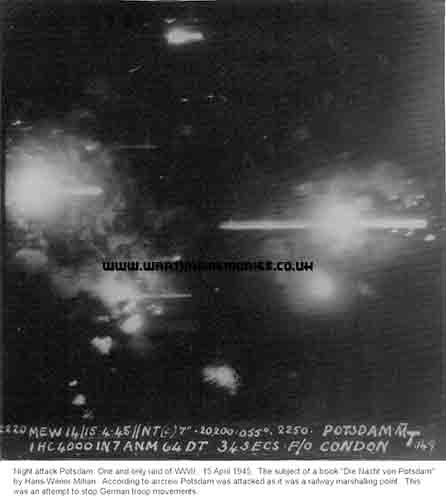 My Dad, Dave Johnston flew with 149 Squadron from RAF Methwold in Norfolk.
The crew in the attached photo (L to R):
- Pilot: Sgt Congdon, R. K. (Bob), Medicine Hat, Alberta, Canada
- Navigator: P/O Johnstone, E. (Ed), Alonsa, Manitoba, Canada
- Bomb Aimer: P/O Johnston, D. G. (Dave), Horizon, Saskatchewan, Canada
- Tail Gunner: Sgt. Caraher, J. H. (Hugh), Stratford, Ontario, Canada
- Wireless Operator: Sgt. Briggs, H. (Harold), Mansfield, Notts, England
- Mid Upper Gunner: Sgt. Terry, H. R., Bracebridge, Ontario, Canada
- Flight Engineer: Hatcher, T., Haywards Heath, Sussex, England
The following was taken from the personal diary of one of the crew members. Personal diaries were not supposed to be kept, however, this diary only contained the dates and the comments below. The operational mission (Ops) target and flight time notations in brackets have been compiled from the actual Flying Log Book of P/O Johnston, D. G., Bomb Aimer.
Refer to the three raid photos attached. Pictures taken by the bomb aimer after dropping the bomb load. Bottom of images show: base MEW, date, altitude, bearing, time, target, bomb load, ?, pilot Congden, plane designation S & T, 149 Squadron
- 24-11-44: First flight in a Lancaster, a wonderful aircraft.
- 11-12-44: Second stage - dead tired.
- 18-12-44: Homings on radar.
- We get a week's leave and on to squadron.
- 14-2-45: Photography only.
- 18-2-45: Our first attempt. quiet. (Ops Wesel, 5:20 day)
- 19-2-45: (Ops Wesel, no entry, diverted to Bottesford, 5:55 day)
- 20-2-45: Ferried a crew to pick up aircraft.
- 22-2-45: Saw one aircraft blow up, a nasty sight. (Ops Oberhausen, 5:10 day)
- 23-2-45: (Ops Gelsenkirchen, no entry, diverted to Acklington, 6:50 day)
- 5-3-45: Lost one aircrew from 149 - F/O Williams, Aussie crew missing saw five chutes. (Ops Gelsenkirchen, 5:20 day)
- 11-3-45: No flak, no fighters. (Ops Essen, 6:10 day)
- 12-3-45: (Ops Dortmund, no entry, 6:30 day)
- 19-3-45: Bags of flakm one bomb aimer killed on his first trip. (Ops Gelsenkirchen, 5:45 day)
- 21-3-45: A fair prang. (Ops Munster, 6:05 day)
- 23-3-45: Troops invaded an hour after. (Ops Wesel, 5:00 day)
- 29-3-45: (Ops Hallendorp, no entry, 6:55 day)
- 4-4-45: Hit several times by flak, very close, holes in a lot of plexiglas. (Ops Mersberg, 8:45 night)
- 14-4-45: About 10 miles from Berlin. (Ops Potsdam, 8:55 night)
- 16-4-45: Low level supply dropping practice, used sand bags.
- 18-4-45: Jettisoned bombs in the North Sea. (Ops Heligoland, aborted, 4:05 day)
- 19-4-45: Home of new German government. (Ops Munich, 7:25 day)
- 26-4-45: Have 3 new engines in our aircraft.
- 1-5-45: Flags waving, people mad. (Spam dropping, The Hague, 2:30 day)
- 5-5-45: Blew a tire on takeoff, landed at Woodbridge, skipper complimented. (Spam dropping, The Hague, 2:20 day)
|
Sgt. Derek Morris 218 (Gold Coast) Squadron (d.31st Dec 1944) Sgt Derek Morris joined the Royal Air Force on 2nd Mar 1943 just short of his 18th birthday. After qualifying as a Flight Engineer on the Lancaster B Mk 1, he and his crew were posted to No. 218 (Gold Coast) Squadron on 12th of August 1944 based at RAF Methwold. Derek married Nancy May Horler on 20th Sep 1944. The Sqn relocated to RAF Chedburgh on 5th Dec 1944.
The official summary for No. 218 (Gold Coast) Sqn operations on the 31st of December 1944 recorded that 17 aircraft were detailed and briefed for operations this day. They departed RAF Chedburgh at 11.15 hours to carry out a daylight bombing mission on the Vohwinkel Railway Marshalling Yards, Solingen in Germany, with 154 other Lancasters from 3 Group. Two aircraft, NF926 and NG330, either collided or one's bombs hit the other and were seen going down in the target area. Nothing was heard from NF926 and NG330 after take-off.
Crew list for Lancaster B Mk 1, NF926 callsign HA-X
- F/O 175154 RAFVR Roy William Woodrow Captain
- Flt Lt 47598 RAF George Neville Chandler 2nd Pilot
- Sgt 1568847 RAFVR William Neil Watson Navigator
- F/S Aus/428566 John Leslie Stagg Wireless Operator
- F/S 1399446 RAFVR Cyril Henry Robert James Bomb Aimer/Air Gunner
- Sgt 1595839 RAF Joseph Carver Mid Upper Gunner
- Sgt 1629751 RAFVR V. Welbourne Rear Gunner
- Sgt 591938 RAFVR Derek Morris Flight Engineer
Further research has established that NF926, from C flight, was probably a G-H leader as the crew included a 2nd pilot and had a bomb load which included Red Target Indicators (TI). It was reported that after leaving the target area NF926 and NG330 collided. The crew of NF926 were on their 27th mission, 26th for Sgt Derek Morris. The crew of NG330, only on their 2nd mission, perished when their aircraft crashed near Solingen.
Research conducted for the website Aircrew Remembered has established that NF926 crashed at around 14:50 hours on Somerstrasse 6 (apparently a workshop) in Solingen, a few kilometres south of the target. It appears that some of the inhabitants, sheltering in a nearby air raid shelter, heard the thump as the aircraft hit the building. F/O Woodrow (Pilot) and Sgt Watson (Navigator) were found alive but badly injured in the wreckage. F/O Woodrow, still strapped into his seat and trapped by his legs pleaded for help from passers-by who ignored him; except for Fritz Schulze, a German policeman who pulled his pistol and shot them both dead. Schulze was arrested in 1945 and tried for the murder of the two airmen before a British Military Court at Hamburg in Jul 1947. He was found guilty and hanged for his crimes on 14th Nov 1947 in Hameln Prison.
Records reveal that Sgt V. Welbourne, the Rear Gunner for NF926, managed to bail out and was subsequently captured. He was repatriated after the war in Europe ended.
Sgt Derek Morris and the rest of the crew of NF926 were originally buried at the Grafrath Cemetery near Solingan. After the war the Commonwealth War Graves Commission reinterred them at the Reichswald Forest War Cemetery on the 27th Feb 1947.
|
Cpl. Leah Valencia My mother, Leah Valencia was at RAF Methwold where she served with the Womens Auxiliary Air Force in WW2. I have found a number of photos, these include photos of her with other servicemen and women and a royal visit with Queen Elizabeth (Queen Mother) and our present Queen.
There are also documents:
Certificate of discharge,
RAF Service and Release book, Christmas Dinner menu for 1941
and an Invitation to a dance in the Sergeant's Mess in 1946.
Mother passed away in January 1999.
|
Recomended Reading.Available at discounted prices.
|
|
|


